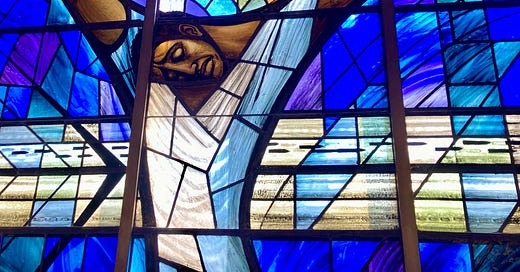If the cross is so counter-intuitive and its meaning can only be grasped by faith, then how does the Church convert people to the message of Christ crucified?
Inside the 16th St Baptist Church in Birmingham, Alabama hangs a stained glass window featuring an arresting depiction of a brown-skinned Christ crucified upon the cross. I say arresting because the image leads the eye in two seemingly dissonant directions. In one direction, Christ’s body appears almost in motion as if he were not truly bound by his captors’ nails. In the other, his anguished visage recalls the Eastern icon called the Utmost Humiliation.
The window was commissioned by the people of Wales in response to the KKK bombing of the church in 1963, which murdered four little black girls. The artist, John Petts, expressed his intent that one arm of the crucified Christ appear turned against the demonic powers of the world while the other arm extends out, ready to embrace all of creation.
Accompanying the image is an inscription from Jesus’ parable of the Last Judgment, which I’d argue has grown rote and impotent by its almost exclusive use to admonish Christians to care for the needybut here gets deployed with convicting power: ‘Whenever you’ve done it to one of the least of these, You Did It to Me.’
Like I said, arresting.
More than that, Petts’ art offers a thick, visual summary of the argument Fleming Rutledge mounts in her latest book, The Crucifixion: Understanding the Death of Jesus Christ, for the Wales Window brings to the fore her emphasis on real, flesh and blood history as the arena in which God in Christ acted upon the cross and in which God through the word of the cross acts still today. Where so much debate today on the atonement veers between the individualistic and the esoteric, Rutledge relentlessly fixes her study of the cross within the challenges and questions raised by a suffering, sinful world. In addition to lived history, the Wales Window highlights several other distinct themes that resonant through The Crucifixion:
Sin not as vices requiring sentimental, pious conversion but as Sin, Powers and Principalities that systemically enslave humanity, requiring liberation. The former is, really, a work of human piety while the latter is an invasion only God can work.
The need for God alone to work justice and to remake the world God created by rectifying the world that humanity, in bondage to Sin, has created.
The sufficiency of Christ’s once-for-all sacrifice upon the cross.
The irreligious, counter-cultural imperative of the New Testament that Christ’s death was offered not only in solidarity with the world’s forsaken and oppressed but ‘for’ the forsakers and oppressors as well.
Keep reading with a 7-day free trial
Subscribe to Tamed Cynic to keep reading this post and get 7 days of free access to the full post archives.




